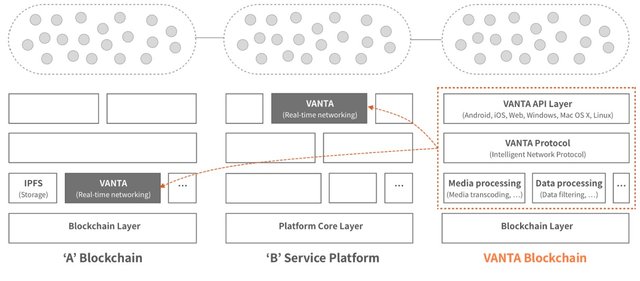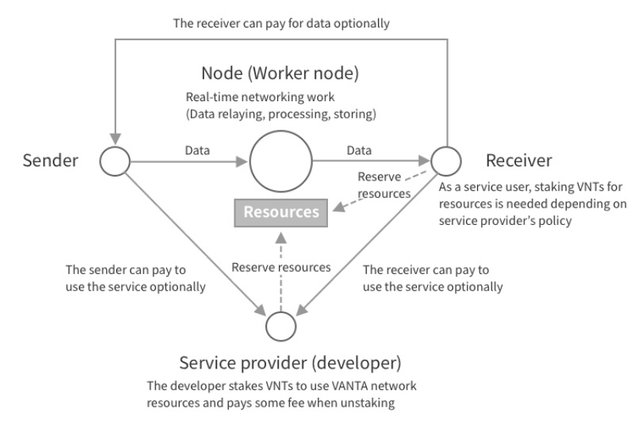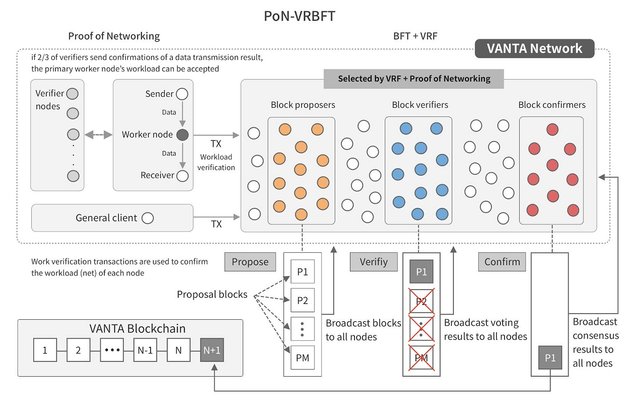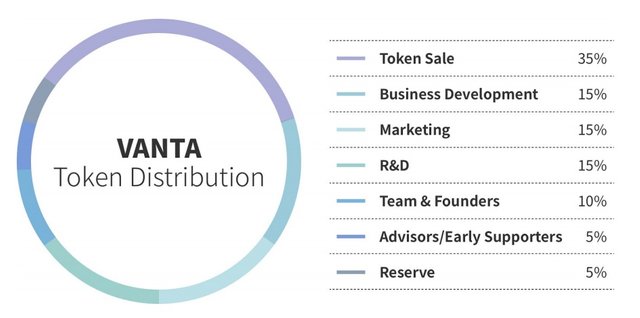- Получить ссылку
- X
- Электронная почта
- Другие приложения
VANTA - Decentralized Network for Real-time, Secure, and Private Connectivity

VANTA
VANTA is looking to build an intelligent network for real-time networking, which enables individuals and companies to quickly develop services that can efficiently transmit and process real-time data, as well as commercialize the services at low cost without additional infrastructure. As a result, creative services will be provided and integrated within the VANTA ecosystem, and VANTA blockchain will be a practical blockchain that will greatly contribute to improving the daily lives of individuals and operations of enterprise businesses.
Real-time networking technology covers a wide range of areas. The technology can be used for messaging / file transfer / voice & video call development, large-scale real-time video streaming, and transmitting & processing various real-time data collected from IoT sensors. Besides addressing these problems through the VANTA blockchain, VANTA will provide and expand enterprise-level telecommunications network solutions to businesses and enterprise customers.
Using blockchain and cryptoeconomics designed for real-time networking, VANTA creates a system in which nodes participating in the network contribute to real-time data transmission and processing without relying on traditional centralized systems and networks. This system results in a low cost, functional blockchain based network. Anyone, regardless of existing platforms, can participate and use the network by using an API, an SDK, or modules to integrate with existing applications or platforms in use. VANTA, therefore, can easily expand the ecosystem through modules that integrate applications and platforms that require real-time networking.
Solution
VANTA will aim to solve the following problems through decentralized intelligent network based on blockchain technology.
1.Increasing Network Throughput and Cost
Current networks and infrastructures that support various real-time networking are reaching throughput limits. This means that companies will not be able to provide reliable services, since network and server costs will increase along with the increasing amount of data transmitted. VANTA will solve the throughput and cost issues by making the common computers and mobile devices around the world, whose performance rapidly increases each year, to contribute to real-time networking.
2.Real-Time Networking Development Costs and Problems with Centralized Services
Many companies are limited (or even fail) to developing real-time networking services because of the cost, time, and lack of skills required to develop and operate such services. As a result, an increasing number of companies are utilizing centralized API services that help develop real-time networking functions. Yet, there are some problems with centralized APIs. Once a centralized API is used, the fee increases significantly as the usage increases. Moreover, if an API provider suddenly changes policies, stops the API service without notice, or experiences temporary downtime, the company developing the services based on the provided API will be adversely affected. Also, because the data is stored on a centralized server, it can not be free from hacking or privacy issues. These problems can be solved by building a decentralized network for real-time networking that is not owned orcontrolled by anyone, and this can be used to provide various real-time networking APIs for companies.
3.Privacy concerns resulting from transferring and storing personal data
In the future, more diverse personal data will flow within the network to be transferred between devices, and will be stored in various centralized servers in order to provide a smooth service experience. However, if users can not know whether if the data is properly encrypted, transmitted, stored, and deleted from the server, users may become anxious due to various hacks as well as government & corporate surveillance. At the same time, personal data leakage will cause great damage. With a blockchain, however, it is possible to transparently confirm the process of transmitting / storing / deleting data. Decentralized nodes, in addition, transmit and store real-time data, which prevent hacking and excessive/malicious use of personal data.
4.Access to data generated by devices and the data usage fees
In the future, there will be an increase in the need to send and receive data in real-time between people and devices and between devices. In such a situation, it is necessary to have a system that can operate transparently and accurately according to the rules determined between the devices without human intervention for acquiring the data access permission automatically, configuring the temporary network for receiving the data, and paying the price for the data use. Therefore, VANTA intends to create an efficient system that can quickly and safely send and receive data in real-time by creating a competitive system that instantly configures networks according to each situation.
5.Trust in the communication between parties and trust in the data transferred from various devices
Currently, various products, stores, and media are evaluated and shared by people. People evaluate the purchase, use, and visitation of products, stores, and media, but there is no evaluation of people or the devices people are communicating with. In the future, there will be more and more real-time communication across people and devices, and credible evaluations will be needed. Trust will achieved in the future whether an individual is engaged in daily life or a company is conducting business.
VANTA Positioning & Competition
Positioning
VANTA is a blockchain specializing in real-time networking. It is a platform blockchain that can solve problems that general-purpose blockchains could not solve, and develop various services requiring real-time networking.
Ethereum or EOS can be classified as platform blockchains while Storj or Golem can be classified as specific-purpose blockchains. Among these blockchains, VANTA is the intelligent network platform that can be classified as both platform blockchain and specific-purpose blockchain. VANTA can be positioned vertically as follows.

Platform & Module
VANTA will build its own ecosystem as a platform blockchain, bringing a variety of real-time networking applications and services. However, VANTA will provide a core module in the form of an SDK and/or API to provide platform-independent access to the VANTA network. Therefore, all platforms and applications that want real-time networking capability can leverage these services, leading to the rapid expansion of the VANTA ecosystem.

Benefits of using VANTA
1.VANTA-based service developers
With VANTA, it is possible to develop and operate scalable, stable, and highly secure real-time networking services at a low cost. Developers can quickly and inexpensively develop real-time networking capabilities based on VANTA without building up a separate server or develop real-time networking from scratch. According to the staking based token economy, developers may utilize
VANTA’s network resources by staking VNT tokens. It is available at no cost, except for a small fee when VNT tokens are unstaked. If a developer does not have enough VNT tokens to secure the resources they need for their service, they have the option to create a policy requiring end users to stake VNT tokens for all or a portion of their own resource usage. In other words, developers and users can share staked VNT tokens to run a service. It enables to significantly reduce the development and operation costs of real-time networking related services.

2.VANTA-based service users
End users using VANTA-based services benefit from lower service costs and privacy. When a service developer stakes sufficient VNT tokens for the service’s network resources, end users usually do not have to stake VNT tokens for their own resource usage. However, if the service is set up for end users to stake VNT tokens to run the service as explained with the previous sections, each user needs to stake VNT tokens for their own resource usage.
Users can also easily create a VANTA account without a separate subscription procedure or authentication. This is possible because network participants communicate through an anonymous hash value that cannot be used to track their identity. Also, users can create a new account at any time, further assuring that an individual cannot be identified. Since there is no central control authority and all data is encrypted and transmitted between peers, it is impossible to provide communication records, data / media, etc. at the request of the central government or authorities. This means that it is possible to use secure, decentralized communication services without privacy problems.
3.Benefits for organizations from adopting VANTA as a telecommunication network
Because VANTA is specialized in real-time networking and has various communication functions, VANTA blockchain can be used by organizations such as governments, businesses, and schools that want to build their own elecommunication network. The VANTA blockchain telecommunication network can be built quickly and cost-effectively without the need for a separate server or infrastructure.
VANTA will also provide direct consulting and customized development for cases in which the government, company, or school, etc. has technical difficulties using VANTA as a telecommunication network. Therefore, it is possible for each organization to build an optimized blockchain based network.
VANTA Blockchain & Consensus Algorithm

The Need for a New Consensus Algorithm
Because VANTA is a blockchain designed for processing real-time networking tasks, a new consensus algorithm is needed for effectively processing it. Previous consensus algorithms were based on Proof-of-Work or Proof-of-Stake and wasted compute power, and thus was unsuitable for use with VANTA. Therefore, VANTA aims to use the computing power and network resources of network nodes to be used for real-time networking, and merge proof for those tasks with block generation and consensus algorithms to create a consensus algorithm optimized for VANTA.
PoN-VRBFT Consensus Algorithm
VANTA has created an algorithm called Proof of Networking that allows each node to contribute to real-time data transmission, processing, and storage in the network competitively. This was combined with Byzantine Fault Tolerance (BFT) and Verifiable Random Functions (VRF) to design a unique consensus algorithm called PoN-VRBFT.
VANTA Token Distribution
The VANTA network consists of 56.2 billion VANTA (VNT) tokens. A total of 35% will be raised via token sales. 10% of tokens will be given to the team who are core contributors for VANTA Network. Most of the portion of the budget will be dedicated to developing for the performance optimization and further function development.The VANTA (VNT) tokens shall be distributed as the following.
Website: https://vanta.network

Roadmap

Links:
Website: https://vanta.network
Whitepaper: https://vanta.network/doc/VANTA_White_Paper.pdf
Facebook: https://www.facebook.com/vantanetwork/
Telegram: https://t.me/vantanetwork
Twitter: https://twitter.com/vantanetwork
Medium: https://medium.com/vantanetwork
Linkedin: https://www.linkedin.com/company/vantanetwork
Reddit: https://www.reddit.com/r/vantanetwork/
Bitcointalk ANN thread: https://bitcointalk.org/index.php?topic=5095100
Whitepaper: https://vanta.network/doc/VANTA_White_Paper.pdf
Facebook: https://www.facebook.com/vantanetwork/
Telegram: https://t.me/vantanetwork
Twitter: https://twitter.com/vantanetwork
Medium: https://medium.com/vantanetwork
Linkedin: https://www.linkedin.com/company/vantanetwork
Reddit: https://www.reddit.com/r/vantanetwork/
Bitcointalk ANN thread: https://bitcointalk.org/index.php?topic=5095100
Username:badgio
Profile:https://bitcointalk.org/index.php?action=profile;u=1252760
Eth:0x9439529B2A09172e299721F19089bb647bd5E1Cc
- Получить ссылку
- X
- Электронная почта
- Другие приложения
Комментарии
Отправить комментарий